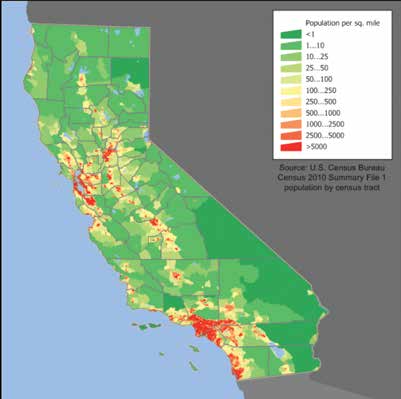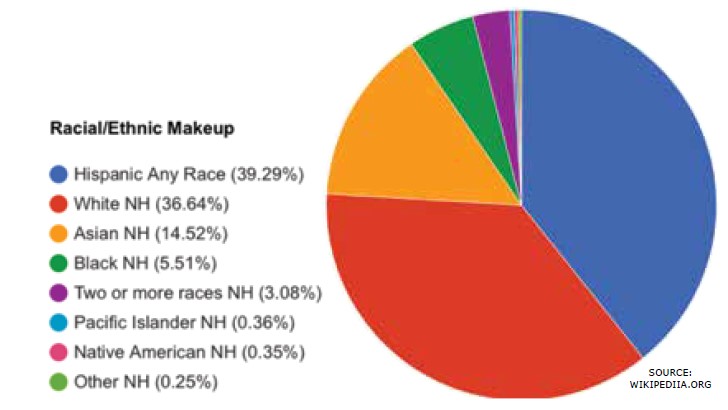
By Eduardo Morales, Ph.D.–
The 2020 U.S. Census recently reported that Latinx individuals comprise the largest ethnic group in California, making up 39.4% of the state’s current population of 39.66 million. Since 2000, the largest ethnic group of children continues to be those identified as Latinx. Many of those who identify as Latinx are also multiracial and multilingual. It is estimated that by 2060, the Latinx population will comprise the majority of those who reside in California.
Currently, Latinxs already form the majority in 13 California counties that include Colusa, Fresno, Glenn, Kern, Kings, Madera, Merced, Monterey, San Benito, San Bernardino, Santa Cruz, Tulare, and Yolo. In the city of Los Angeles, 48.5% identify as Latinx; in the county of Los Angeles, 45% are Latinx.
In the San Francisco Bay Area, increases of Latinxs were noted in 7 of the 9 counties with an average of a 5% increase. According to the UCLA William Institute Report, 5.3% of the California population identifies as LGBT. Among them, 48% are white non-Latinx and 35% are Latinx. https://tinyurl.com/be6mkftw
In response to these changing demographics in CA, Governor Gavin Newsom on September 30, 2020, signed into law a bill (AB 979) that requires publicly held companies headquartered in the state to include board members from underrepresented communities. This action follows passage of a similar law in 2018 mandating that public companies headquartered in the state have at least one woman on their board of directors by the end of 2019 (SB 826), with further future increases required depending on board size.

In summary, AB 979 requires that, by the end of 2021, California-headquartered public companies have at least one director on their board who is from an underrepresented community, defined as “an individual who self‑identifies as Black, African American, Hispanic, Latino, Asian, Pacific Islander, Native American, Native Hawaiian, or Alaska Native, or who self‑identifies as gay, lesbian, bisexual, or transgender.” In addition, this law mandates that the number of directors from underrepresented communities be increased by the end of calendar year 2022, depending on the size of the board.
Ethnic Studies Requirement
On October 8, 2021, John Fensterwald reported in EdSource: Highlighting Strategies for Student Success: “Gov. Gavin Newsom signed legislation Friday making California the first state to require all students to complete a semester-long course in ethnic studies to earn a high school diploma. The mandate will take effect starting with the graduating class of 2029–30, although high schools must start to offer courses starting in the 2025–26 school year. Hundreds of high schools already have such courses, and Los Angeles Unified and Fresno Unified voted last year to require students to take ethnic studies.”
Newsom’s signature of Assembly Bill 101, authored by Assemblyman Jose Medina, D-Riverside, ends a decades-long quest by advocates for a curriculum that more closely reflects the history, culture, and struggles of California’s diverse population. And it comes one year after Newsom vetoed a nearly identical bill amid strenuous opposition to the first draft of a model ethnic studies curriculum that critics, particularly Jewish organizations, dismissed as prejudiced and discriminatory.
The legislation authorizing the creation of an ethnic studies curriculum stated that it should draw attention to the four ethnic and racial groups whose history and stories have been traditionally overlooked and have been the focus of college ethnic studies courses: Blacks, Latinos, Native Americans, and Asian Americans. The model curriculum does that while encouraging schools to include discussions on the ethnic heritage and the legacies of students in their communities. The model curriculum includes lesson plans on Sikh, Jewish, Arab, and Armenian Americans, which were added after those groups objected to being left out in earlier drafts.
Historic Latinx and LGBT Organizations
The Bay Area has a unique history concerning Latinx persons, organizations, and activities. For example, Club Puertoriqueño de San Francisco, Inc., located at 3249-A Mission Street in San Francisco, was incorporated on February 25, 1912, and is the oldest Latinx organization in the United States. The League of United Latin American Citizens, also referred to as LULAC, was founded in 1929 in Corpus Christi, Texas, and is the largest national Latinx organization in the U.S. AGUILAS, founded in 1991, is the oldest Latinx LGBT organization in all of the Americas.
SF Latinx Arts
This year, the 13th San Francisco Latinx Film Festival is being held throughout fall by Cine+Mas SF. Carlos Santana—a 10-time Grammy winner, Rock and Roll Hall of Fame member, and global music icon, who was born in Mexico and raised in San Francisco—just received the 2021 Hispanic Heritage Legend Award by the Hispanic Heritage Foundation. His career soared when his band Santana performed at the famed Woodstock Music and Arts Festival in 1969.
Actor and producer Benjamin Bratt was born and raised in San Francisco. Jerry Garcia—famed guitarist, singer, and songwriter and lead guitarist and a vocalist with the band the Grateful Dead—was born and raised in San Francisco. Vermont ice cream maker Ben & Jerry’s introduced their first ice cream flavor dedicated to a musician called Cherry Garcia.
Día de los Muertos, Carnival
Día de los Muertos, recognized on November 2 and referred to as All Souls Day, is a day of remembrance for those who have died. This day is celebrated in various forms throughout Latin American countries and in the U.S. among Latinx communities. Prior to the COVID-19 pandemic, San Francisco held its parade and celebration in the Mission District regularly for Día de los Muertos.
Carnival is another festivity celebrated throughout Latin America, including San Francisco. Due to weather conditions, San Francisco celebrates Carnival annually with a parade and festival during the month of May. Celebrated before the start of the season of Lent, Carnival is a celebration of life, with one of the largest celebrations held in Rio De Janeiro, Brazil. Rio’s Carnival parade and celebration are held in their Sambódrome, where numerous samba schools containing more than 4,000 members per school parade over several days and where the festivities are televised throughout the world.

Recommended Viewing
You can view some of the amazing Sambódrome celebrations over the years on YouTube. You can also watch a very informative series created by public television called Latino Americans on YouTube. You will be surprised at how Latinx persons were excluded and ostracized throughout the U.S.
For example, in the 1961 movie West Side Story, the film presents the tensions in New York City between Puerto Ricans who are members of the gang called the Sharks and a white gang who called themselves the Jets. In this film, there was only one Puerto Rican person who was cast: Rita Moreno, who calls Berkeley home and who received the 1962 Oscar for Best Supporting Actress portraying the part of Anita.
The upcoming new remake of West Side Story is scheduled to be released in theaters on December 10. Directed by Steven Spielberg, the film includes Moreno as one of its stars. The remake supposedly attempts to correct some of the casting and exclusion issues of the original 1961 film. Check out the trailer here: https://tinyurl.com/vz29mv2c
Eduardo Morales, Ph.D., is a founder of AGUILAS, where he serves as Executive Director. He is also a retired Distinguished Professor at Alliant International University and is the 2021 President of the National Latinx Psychological Association.
Published on October 21, 2021
Recent Comments